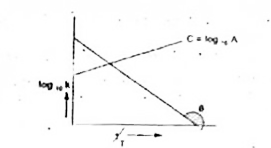The activation energy for a reaction when the temperature is raised from 300K to 310K is
50.6kJmol−1
53.6kJmol−1
56.6kJmol−1
59.6kJmol−1
The correct Answer is:B
b) According to Arrhenius equation,
log(K2)K1=Ea2.303[1T1−1T2]
log(2K1)K1=Ea2.303R[1T1−1T2]
log2=Ea2.303×8.314Jk−1mol−1⎡⎣1300K−1310K⎤⎦
0.30=Ea2.303×(8.314Jmol−1)×(9300)
=53.6kjmol−1

Topper's Solved these Questions
- CHEMICAL KINETICSBOOK - DINESH PUBLICATIONCHAPTER - CHEMICAL KINETICSEXERCISE - Comprehension type
14 Videos
- CHEMICAL KINETICSBOOK - DINESH PUBLICATIONCHAPTER - CHEMICAL KINETICSEXERCISE - Stright objective types MCQs
24 Videos
- CHEMICAL KINETICSBOOK - DINESH PUBLICATIONCHAPTER - CHEMICAL KINETICSEXERCISE - Effect of temperature and catalyst on rate of reaction.
15 Videos
- CHEMICAL BONDING AND MOLECULAR STRUCTUREBOOK - DINESH PUBLICATIONCHAPTER - CHEMICAL BONDING AND MOLECULAR STRUCTUREEXERCISE - Unit Test - 1
20 Videos
- CHEMICAL THERMODYNAMICS AND CHEMICAL ENERGETICS BOOK - DINESH PUBLICATIONCHAPTER - CHEMICAL THERMODYNAMICS AND CHEMICAL ENERGETICS EXERCISE - Exercise
507 Videos
Similar Questions
The rate of a reaction increases by 2.5 times when the temperature is raised from 300K to 310K. If K is the rate constant at 310 K will be equal to
View SolutionThe activation energy for a reaction that doubles the rate when the temperature is raised from 300 K to 310 K is (log 2 = 0.3)
View Solution
Knowledge Check
The rate of a reaction increases by 2.5 times when the temperature is raised from 300K to 310K. If K is the rate constant at 310 K will be equal to
AKB2KC2.5KD3KThe activation energy for a reaction that doubles the rate when the temperature is raised from 300 K to 310 K is (log 2 = 0.3)
A50.6kJmol−1B75.45kJmol−1C45.5kJmol−1D53.4kJmol−1When the temperature is increased, heat is supplied which increases the kinetic energy of the reacting molecules. This shall increase the number of collisions and ultimately the rate of reaction shall be enhanced. Arrhenius suggested a equation which describes K as a function of temperature, i.e.
k=Ae−Ea/RT
where
k= rate constant
A= a constant (frequency factor)
Ea= energy of activation
log10k=log10A−Ea2.303R[1R]
Y=C+MX
It is the equation of straight line with negative slope. On plotting log10k against [1T] we get a straight line as shown below :

The slope gives activation energy and intercept gives frequency factor.
Also log.k2k1=Ea2.303[T2−T1T1T2]
The rate of certain reaction increases by 2.5 times when the temperature is raised from 300K to 310K. If k is the rate constant at 300K then rate constant at 310K will be equal toAkB2kC2.5kD13k
Two reaction, (I)A→ Products and (II)B→ Products, follow first order kinetics. The rate of reaction (I) is doubled when the temperature is raised form 300K to 310K. The half life for this reaction at 310K is 30min. At the same temperature B decomposes twice as fast as A. If the energy of activation for reaction (II) is twice that of reaction (I), (a) calculate the rate of constant of reaction (II) at 300K.
View SolutionTwo reaction, (I)A→ Products and (II)B→ Products, follow first order kinetics. The rate of reaction (I) is doubled when the temperature is raised form 300K to 310K. The half life for this reaction at 310K is 30min. At the same temperature B decomposes twice as fast as A. If the energy of activation for reaction (II) is twice that of reaction (I), (a) calculate the rate of constant of reaction (II) at 300K.
View SolutionTwo reactions, (i)A→ products and (ii)B→ products , follow first order kinetics. The rate of the reaction (i) is doubled when the temperature is raised from 300K to 310K. The half life for this reaction at 310K is 30 minutes. At the same temperature B decomposes twice as fast as A. If the energy of activation for the reaction (i) is half that of reaction (ii) calculate the rate constant of the reaction (ii) at 300K.
View SolutionThe rate of a reaction increases to 2.3 times when the temperature is raised form 300K to 310K. If Q is the rate constant at 300K, then the rate constant at 310K will be equal to
View SolutionThe rates of most reaction double when their temperature is raised from 298K to 308K. Calculate their activation energy.
View Solution
